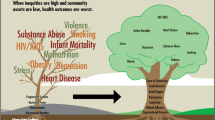Abstract
Faith and public health partnerships offer promise to addressing health disparities, but examples that incorporate African-Americans and Latino congregations are lacking. Here we present results from developing a multi-ethnic, multi-denominational faith and public health partnership to address health disparities through community-based participatory research (CBPR), focusing on several key issues: (1) the multi-layered governance structure and activities to establish the partnership and identify initial health priority (obesity), (2) characteristics of the congregations recruited to partnership (n = 66), and (3) the lessons learned from participating congregations’ past work on obesity that informed the development of a multi-level, multi-component, church-based intervention. Having diverse staff with deep ties in the faith community, both among researchers and the primary community partner agency, was key to recruiting African-American and Latino churches. Involvement by local health department and community health clinic personnel provided technical expertise and support regarding health data and clinical resources. Selecting a health issue—obesity—that affected all subgroups (e.g., African-Americans and Latinos, women and men, children and adults) garnered high enthusiasm among partners, as did including some innovative aspects such as a text/e-mail messaging component and a community mapping exercise to identify issues for advocacy. Funding that allowed for an extensive community engagement and planning process was key to successfully implementing a CBPR approach. Building partnerships through which multiple CBPR initiatives can be done offers efficiencies and sustainability in terms of programmatic activities, though long-term infrastructure grants, institutional support, and non-research funding from local foundations and health systems are likely needed.


Similar content being viewed by others

References
Frieden TR. Foreword. CDC health disparities and inequalities report—United States, 2013. MMWR Morb Mortal Wkly Rep. 2013;62(Suppl 3):1–2.
Gu A, Yue Y, Desai RP, Argulian E. Racial and ethnic differences in antihypertensive medication use and blood pressure control among US adults with hypertension: the National Health and Nutrition Examination Survey, 2003 to 2012. Circ Cardiovas Qual Outcomes. 2017;10(1). doi:https://doi.org/10.1161/circoutcomes.116.003166.
Spanakis EK, Golden SH. Race/ethnic difference in diabetes and diabetic complications. Curr Diab Rep. 2013;13(6):814–23. https://doi.org/10.1007/s11892-013-0421-9.
Zonderman AB, Ejiogu N, Norbeck J, Evans MK. The influence of health disparities on targeting cancer prevention efforts. Am J Prev Med. 2014;46(3 Suppl 1):S87–97. https://doi.org/10.1016/j.amepre.2013.10.026.
Jackson CS, Oman M, Patel AM, Vega KJ. Health disparities in colorectal cancer among racial and ethnic minorities in the United States. J Gastrointest Oncol. 2016;7(Suppl 1):S32–43. https://doi.org/10.3978/j.issn.2078-6891.2015.039.
O’Keefe EB, Meltzer JP, Bethea TN. Health disparities and cancer: racial disparities in cancer mortality in the United States, 2000–2010. Front Public Health. 2015;3:51. https://doi.org/10.3389/fpubh.2015.00051.
Harper SB, Lynch J. Selected comparisons of measures of health disparities: a review using databases relevant to healthy people 2010 cancer-related objectives. US Department of Health and Human Services, National Institutes of Health, National Cancer Institute: Department of Epidemiology B, and Occupational Health 2007. https://seer.cancer.gov/publications/disparities2
Gant Z, Dailey A, Hu X, Johnson AS. HIV care outcomes among Hispanics or Latinos with diagnosed HIV infection—United States, 2015. MMWR Morb Mortal Wkly Rep. 2017;66(40):1065–72. https://doi.org/10.15585/mmwr.mm6640a2.
Wong RJ, Chou C, Ahmed A. Long term trends and racial/ethnic disparities in the prevalence of obesity. J Community Health. 2014;39(6):1150–60. https://doi.org/10.1007/s10900-014-9870-6.
Agency for Healthcare Research and Quality. 2010 National healthcare quality and disparities reports. Rockville, MD. http://archive.ahrq.gov/research/findings/nhqrdr/nhqrdr10/qrdr10.html. Accessed March 11 2018.
Fiscella K, Franks P, Doescher MP, Saver BG. Disparities in health care by race, ethnicity, and language among the insured—findings from a national sample. Med Care. 2002;40(1):52–9.
Institute of Medicine (US). Unequal treatment: confronting racial and ethnic disparities in health care. Washington, DC: National Academies Press; 2003.
Sommers BD, Gunja MZ, Finegold K, Musco T. Changes in self-reported insurance coverage, access to care, and health under the Affordable Care Act. JAMA. 2015;314(4):366–74. https://doi.org/10.1001/jama.2015.8421.
Cooper-Patrick L, Gallo J, Gonzales J, Vu H, Powe N, Nelson C, et al. Race, gender, and partnership in the patient-physician relationship. JAMA. 1999;282(6):583–9.
Doescher M, Saver B, Franks P, Fiscella K. Racial and ethnic disparities in perceptions of physician style and trust. Arch Fam Med. 2000;9(10):1156–63.
Boardman JD, Saint Onge JM, Rogers RG, Denney JT. Race differentials in obesity: the impact of place. J Health Soc Behav. 2005;46(3):229–43.
Kawachi I. Income inequality and health. In: Berkman LF, Kawachi I, editors. Social epidemiology. Oxford: Oxford University Press; 2000.
Kawachi I, Kennedy BP. Socioeconomic determinants of health: health and social cohesion: why care about income inequality? BMJ. 1997;314(7086):1037–40.
Willard R, Shah GH, Leep C, Ku L. Impact of the 2008-2010 economic recession on local health departments. J Public Health Manag Pract. 2012;18(2):106–14. https://doi.org/10.1097/PHH.0b013e3182461cf2.
Wholey DR, Gregg W, Moscovice I. Public health systems: a social networks perspective. Health Serv Res. 2009;44(5 Pt 2):1842–62.
Barnes PA, Curtis AB. A national examination of partnerships among local health departments and faith communities in the United States. J Public Health Manag Pract. 2009;15(3):253–63.
Chaves M. Congregations in America. Cambridge: Harvard University Press; 2004.
Idler EL, Musick MA, Ellison CG. Measuring multiple dimensions of religion and spirituality for health research: conceptual background and findings from the 1998 General Social Survey. Res Aging. 2003;25(4):327–65.
Pew Research Center. Religious landscape study. Washington, DC. 2014. http://www.pewforum.org/religious-landscape-study/. Accessed February 27 2018.
Taylor RJ, Mattis J, Chatters LM. Subjective religiosity among African Americans: a synthesis of findings from five national samples. J Black Psychol. 1999;25(4):524–43. https://doi.org/10.1177/0095798499025004004.
National Congregations Study. Religious Congregations in the 21st Century America 2015. http://www.soc.duke.edu/natcong/Docs/NCSIII_report_final.pdf. Accessed April 17 2018.
Chaves M, Anderson SL. Continuity and change in American congregations: introducing the second wave of the National Congregations Study. Sociol Relig. 2008;69(4):415–40.
Chaves M, Tsitsos W. Congregations and social services: what they do, how they do it, and with whom. Nonprofit Volunt Sect Q. 2001;30(4):660–83. https://doi.org/10.1177/0899764001304003.
Williams MV, Haas A, Griffin BA, Fulton BR, Kanouse DE, Bogart LM, et al. Predictors of the existence of congregational HIV programs: similarities and differences compared with other health programs. Am J Health Promot. 2015;29(6):e225–35. https://doi.org/10.4278/ajhp.130531-QUAN-280.
Taylor RJ, Chatters LM. Black and White differences in religious participation: a multisample comparison. J Sci Study Relig. 1996;35(4):403–10.
Anderson RN. Deaths: leading causes for 2000. Natl Vital Stat Rep. 2002;50(16):1-85.
Lasater TM, Becker DM, Hill MN, Gans KM. Synthesis of findings and issues from religious-based cardiovascular disease prevention trials. Ann Epidemiol. 1997;7(S7):S546–S53.
DeHaven MJ, Hunter IB, Wilder L, Walton JW, Berry J. Health programs in faith-based organizations: are they effective? Am J Public Health. 2004;94(6):1030–6.
Campbell MK, Hudson MA, Resnicow K, Blakeney N, Paxton A, Baskin M. Church-based health promotion interventions: evidence and lessons learned. Annu Rev Public Health. 2007;28:213–34. https://doi.org/10.1146/annurev.publhealth.28.021406.144016.
Goldmon M, Roberson JT Jr, Carey T, Godley P, Howard DL, Boyd C et al. The data collection/data distribution center: building a sustainable African-American church-based research network. Prog Community Health Partnersh. 2008;2(3):205-24.
Israel BA, Schulz AJ, Parker EA, Becker AB. Review of community-based research: assessing partnership approaches to improve public health. Annu Rev Public Health. 1998;19:173–202. https://doi.org/10.1146/annurev.publhealth.19.1.173.
Cadge W, Ecklund E. Religious service attendance among immigrants: evidence from the new immigrant survey-pilot. Am Behav Sci. 2006;49(11):1574–95.
De Marco M, Weiner B, Meade SA, Hadley M, Boyd C, Goldmon M, et al. Assessing the readiness of black churches to engage in health disparities research. J Natl Med Assoc. 2011;103(9–10):960–7.
Kaplan SA, Ruddock C, Golub M, Davis J, Foley R Sr, Devia C, et al. Stirring up the mud: using a community-based participatory approach to address health disparities through a faith-based initiative. J Health Care Poor Underserved. 2009;20(4):1111–23. https://doi.org/10.1353/hpu.0.0221.
Sallis JE, Cervero RB, Ascher W, Henderson KA, Kraft MK, Kerr J. An ecological approach to creating active living communities. Annu Rev Public Health. 2006;27:297–322. https://doi.org/10.1146/annurev.publhealth.27.021405.102100.
Dalal S, Khodyakov D, Srinivasan R, Straus S, Adams J. ExpertLens: a system for eliciting opinions from a large pool of non-collocated experts with diverse knowledge. Technol Forecast Soc Chang. 2011;78(8):1426–44. https://doi.org/10.1016/j.techfore.2011.03.021.
Kaplan SA, Calman NS, Golub M, Ruddock C, Billings J. The role of faith-based institutions in addressing health disparities: a case study of an initiative in the Southwest Bronx. J Health Care Poor Underserved. 2006;17(2 Suppl):9–19. https://doi.org/10.1353/hpu.2006.0088.
Resnicow K, Campbell M, Carr C, McCarty F, Wang T, Periasamy S, et al. Body and soul: a dietary intervention conducted through African-American churches. Am J Prev Med. 2004;27(2):97–105. https://doi.org/10.1016/j.amepre.2004.04.009.
Campbell MK, Resnicow K, Carr C, Wang T, Williams A. Process evaluation of an effective church-based diet intervention: body & soul. Health Educ Behav. 2007;34(6):864–80. https://doi.org/10.1177/1090198106292020.
Derose KP, Mendel PJ, Palar K, Kanouse DE, Bluthenthal RN, Castaneda LW, et al. Religious congregations' involvement in HIV: a case study approach. AIDS Behav. 2011;15(6):1220–32. https://doi.org/10.1007/s10461-010-9827-4.
Payan DD, Florez KR, Bogart LM, Kanouse DE, Mata MA, Oden CW et al. Promoting health from the pulpit: a process evaluation of HIV sermons to reduce HIV stigma and promote testing in African American and Latino churches. J Health Commun 2017:1–10. doi:https://doi.org/10.1080/10410236.2017.1384352.
Resnicow K, Taylor R, Baskin M, McCarty F. Results of go girls: a weight control program for overweight African-American adolescent females. Obes Res Clin Pract. 2005;13(10):1739–48. https://doi.org/10.1038/oby.2005.212.
Resnicow K, Jackson A, Blissett D, Wang T, McCarty F, Rahotep S, et al. Results of the healthy body healthy spirit trial. Health Psychol. 2005;24(4):339–48. https://doi.org/10.1037/0278-6133.24.4.339.
Samuel-Hodge CD, Keyserling TC, Park S, Johnston LF, Gizlice Z, Bangdiwala SI. A randomized trial of a church-based diabetes self-management program for African Americans with type 2 diabetes. Diabetes Educ. 2009;35(3):439–54. https://doi.org/10.1177/0145721709333270.
Winett RA, Anderson ES, Wojcik JR, Winett SG, Bowden T. Guide to health: nutrition and physical activity outcomes of a group-randomized trial of an Internet-based intervention in churches. Ann Behav Med. 2007;33(3):251–61. https://doi.org/10.1080/08836610701358045.
Wilcox S, Parrott A, Baruth M, Laken M, Condrasky M, Saunders R, et al. The faith, activity, and nutrition program: a randomized controlled trial in African-American churches. Am J Prev Med. 2013;44(2):122–31. https://doi.org/10.1016/j.amepre.2012.09.062.
Le D, Holt CL, Saunders DR, Wang MQ, Coriolan A, Savoy AD, et al. Feasibility and acceptability of SMS text messaging in a prostate cancer educational intervention for African American men. Health Informatics J. 2016;22(4):932–47. https://doi.org/10.1177/1460458215598636.
Campbell MK, Motsinger BM, Ingram A, Jewell D, Makarushka C, Beatty B, et al. The North Carolina Black Churches United for better health project: intervention and process evaluation. Health Educ Behav. 2000;27(2):241–53.
Campbell MK, Demark-Wahnefried W, Symons M, Kalsbeek WD, Dodds J, Cowan A, et al. Fruit and vegetable consumption and prevention of cancer: the Black Churches United for Better Health project. Am J Public Health. 1999;89(9):1390–6.
White-Cooper S, Lewis EY, Greene-Moton E, Grunbaum JA, Gray B. Community engagement in prevention research: the Centers for Disease Control and Prevention's Prevention Research Centers’ National Community Committee. Prog Community Health Partnersh. 2009;3(1):73–81. https://doi.org/10.1353/cpr.0.0047.
Hoeft TJ, Burke W, Hopkins SE, Charles W, Trinidad SB, James RD, et al. Building partnerships in community-based participatory research: budgetary and other cost considerations. Health Promot Pract. 2014;15(2):263–70. https://doi.org/10.1177/1524839913485962.
Acknowledgments
This study was supported by the National Institute of Minority Health and Health Disparities of the National Institutes of Health under Award Number R24MD007943 (PI: Derose). The content is solely the responsibility of the authors and does not necessarily represent the official views of the National Institutes of Health. The authors acknowledge the important role played by the LAM Faith Organizers, Rev. Jawane Hilton, and Rev. Juan Sarmiento, in recruiting churches to the partnership, and the broad and sustained contributions of other members of the Community Steering Committee, especially Rev. Rosalynn Brooks, Rev. John Cager, Rev. Walter Contreras, Jaime Huerta, Rev. Martín García, Dr. Jan King, Rev. Felipe Martínez, Bp. Gwendolyn Stone, Nina Vaccaro, and Bp. Craig Worsham.
Author information
Authors and Affiliations
Corresponding author
Ethics declarations
The study was approved by the RAND Human Subjects Projection Committee. Informed consent was obtained from all individual participants included in the study.
Conflict of Interest
The authors declare that they have no conflict of interest.
Rights and permissions
About this article
Cite this article
Derose, K.P., Williams, M.V., Branch, C. et al. A Community-Partnered Approach to Developing Church-Based Interventions to Reduce Health Disparities Among African-Americans and Latinos. J. Racial and Ethnic Health Disparities 6, 254–264 (2019). https://doi.org/10.1007/s40615-018-0520-z
Received:
Revised:
Accepted:
Published:
Issue Date:
DOI: https://doi.org/10.1007/s40615-018-0520-z



